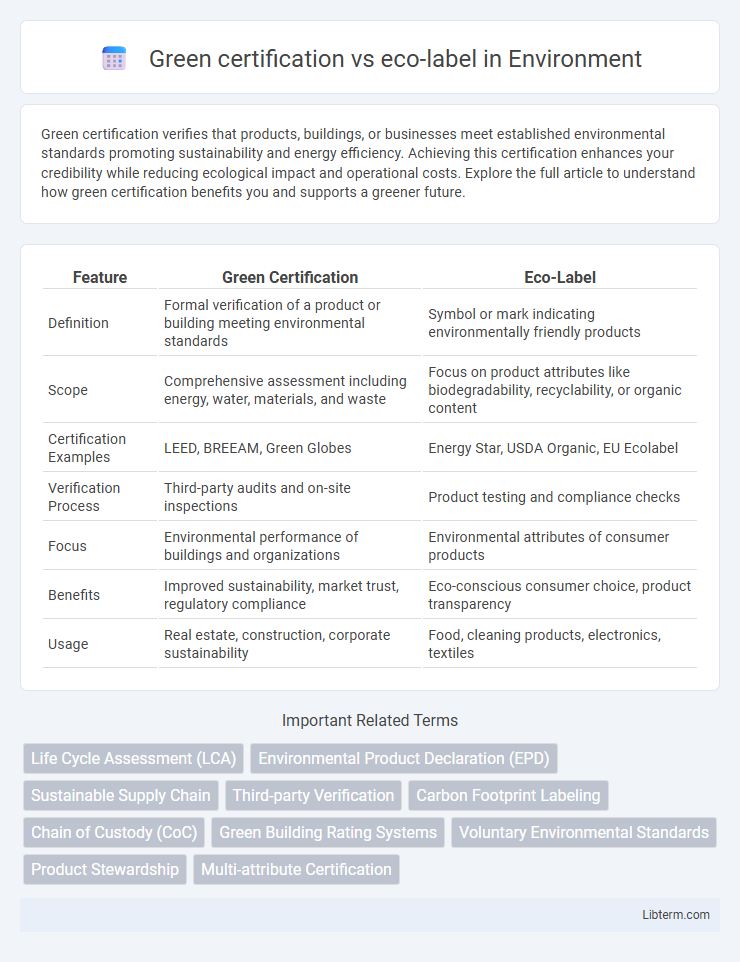Green certification verifies that products, buildings, or businesses meet established environmental standards promoting sustainability and energy efficiency. Achieving this certification enhances your credibility while reducing ecological impact and operational costs. Explore the full article to understand how green certification benefits you and supports a greener future.
Table of Comparison
| Feature | Green Certification | Eco-Label |
|---|---|---|
| Definition | Formal verification of a product or building meeting environmental standards | Symbol or mark indicating environmentally friendly products |
| Scope | Comprehensive assessment including energy, water, materials, and waste | Focus on product attributes like biodegradability, recyclability, or organic content |
| Certification Examples | LEED, BREEAM, Green Globes | Energy Star, USDA Organic, EU Ecolabel |
| Verification Process | Third-party audits and on-site inspections | Product testing and compliance checks |
| Focus | Environmental performance of buildings and organizations | Environmental attributes of consumer products |
| Benefits | Improved sustainability, market trust, regulatory compliance | Eco-conscious consumer choice, product transparency |
| Usage | Real estate, construction, corporate sustainability | Food, cleaning products, electronics, textiles |
Understanding Green Certification and Eco-Labels
Green certification and eco-labels both serve to verify environmental standards, yet green certification typically involves a comprehensive assessment of an organization's sustainability practices, such as energy efficiency, waste management, and carbon footprint reduction. Eco-labels specifically highlight environmentally friendly products or services, providing consumers with easily recognizable marks that indicate compliance with particular ecological criteria, like biodegradable materials or organic sourcing. Understanding these distinctions enables businesses and consumers to make informed decisions that promote sustainability through credible, certified environmental commitments.
Key Differences Between Green Certifications and Eco-Labels
Green certifications involve comprehensive evaluation processes verifying an organization's or product's adherence to environmental standards, often requiring third-party audits and detailed sustainability criteria. Eco-labels are simplified, easily recognizable marks on products that signify compliance with specific environmental attributes, aimed at guiding consumer choices quickly. Key differences include scope--green certifications typically assess broader operational impacts, while eco-labels focus on specific product features or lifecycle aspects.
Criteria and Standards: What Sets Them Apart
Green certification involves meeting comprehensive environmental management criteria verified by accredited organizations, emphasizing sustainable practices across the entire production process. Eco-labels focus on specific product attributes, with standards designed to highlight reduced environmental impact or resource efficiency in consumer goods. The key distinction lies in green certification's broader scope and rigorous auditing, whereas eco-labels provide targeted environmental information to guide consumer choices.
Benefits of Green Certification for Businesses
Green certification enhances business credibility by demonstrating a verified commitment to environmental sustainability, which attracts eco-conscious customers and investors. It often leads to cost savings through improved resource efficiency and waste reduction, boosting profitability. Businesses with green certification gain a competitive edge in the market, meeting regulatory requirements and easing access to green procurement opportunities.
The Role of Eco-Labels in Consumer Choices
Eco-labels significantly influence consumer choices by providing clear, trustworthy information about a product's environmental impact, helping buyers make sustainable decisions. Unlike green certification, which often involves comprehensive, technical assessments by third parties, eco-labels focus on specific eco-friendly attributes, making it easier for consumers to identify greener products quickly. Studies show that visible eco-labels on packaging increase the likelihood of purchase among environmentally conscious shoppers, reinforcing the role of marketing in promoting sustainable consumption.
Verification and Transparency: Behind the Labels
Green certification involves rigorous third-party verification processes ensuring compliance with environmental standards, enhancing transparency and credibility for consumers. Eco-labels are often governed by independent organizations that audit product claims and performance, providing clear, verifiable information about environmental impact. Both systems prioritize transparency by offering accessible data and certification details, enabling informed consumer choices based on verified ecological benefits.
Popular Examples of Green Certifications
Popular examples of green certifications include LEED (Leadership in Energy and Environmental Design) for sustainable building practices, Energy Star for energy-efficient appliances and electronics, and FSC (Forest Stewardship Council) certification for responsibly sourced wood products. Eco-labels, such as the EU Ecolabel and USDA Organic, specifically indicate environmentally friendly product attributes to consumers, emphasizing minimal ecological impact. Both green certifications and eco-labels promote environmental stewardship but differ in scope, with certifications often targeting industry standards and eco-labels focusing on consumer product choices.
Notable Eco-Labels in the Marketplace
Notable eco-labels in the marketplace, such as Energy Star, USDA Organic, and Forest Stewardship Council (FSC), certify products based on stringent environmental criteria, promoting sustainability and consumer trust. Green certification programs often encompass broader sustainability practices, including corporate environmental policies and supply chain impacts, distinguishing them from product-specific eco-labels. Consumers increasingly rely on recognized eco-labels to identify environmentally responsible products, driving market demand for transparent and verified green claims.
Challenges and Criticisms of Both Systems
Green certification and eco-label systems face significant challenges including inconsistent standards, lack of transparency, and potential greenwashing, which undermine consumer trust. Both systems struggle with verifying continuous compliance and adapting to diverse regional environmental criteria, leading to confusion and limited global applicability. Critics argue that high certification costs disproportionately affect small businesses, restricting broader adoption and reducing the overall impact of these sustainability tools.
Choosing the Right Path: Green Certification vs Eco-Label
Choosing the right path between green certification and eco-label depends on your sustainability goals and market demands. Green certification typically involves comprehensive third-party verification of environmental practices across operations, ensuring compliance with rigorous standards. Eco-labels, on the other hand, focus on communicating specific environmental attributes of a product directly to consumers, enhancing brand transparency and influencing purchase decisions.
Green certification Infographic

 libterm.com
libterm.com